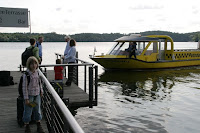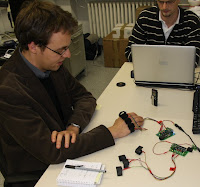This year we have the chance to share some of our research with the community at CHI2012. The work focuses on usable security ([1] and [2]) and public display systems [3]. Florian got together with the researchers from T-Labs a best paper award for [3].
Please have a look at the papers… I think it is really worthwhile.
Increasing the security of gaze-based graphical passwords [1]
“With computers being used ever more ubiquitously in situations where privacy is important, secure user authentication is a central requirement. Gaze-based graphical passwords are a particularly promising means for shoulder-surfing-resistant authentication, but selecting secure passwords remains challenging. In this paper, we present a novel gaze-based authentication scheme that makes use of cued-recall graphical passwords on a single image. In order to increase password essays security, our approach uses a computational model of visual attention to mask those areas of the image that are most likely to attract visual attention. We create a realistic threat model for attacks that may occur in public settings, such as filming the user’s interaction while drawing money from an ATM. Based on a 12-participant user study, we show that our approach is significantly more secure than a standard image-based authentication and gaze-based 4-digit PIN entry.” [1]
Assessing the vulnerability of magnetic gestural authentication [2]
“Secure user authentication on mobile phones is crucial, as they store highly sensitive information. Common approaches to authenticate a user on a mobile phone are based either on entering a PIN, a password, or drawing a pattern. However, these authentication methods are vulnerable to the shoulder surfing attack. The risk of this attack has increased since means for recording high-resolution videos are cheaply and widely accessible. If the attacker can videotape the authentication process, PINs, passwords, and patterns do not even provide the most basic level of security. In this project, we assessed the vulnerability of a magnetic gestural authentication method to the video-based shoulder surfing attack. We chose a scenario that is favourable to the attacker. In a real world environment, we videotaped the interactions of four users performing magnetic signatures on a phone, in the presence of HD cameras from four different angles. We then recruited 22 participants and asked them to watch the videos and try to forge the signatures. The results revealed that with a certain threshold, i.e, th=1.67, none of the forging attacks was successful, whereas at this level all eligible login attempts were successfully recognized. The qualitative feedback also indicated that users found the magnetic gestural signature authentication method to be more secure than PIN-based and 2D signature methods.“[2] There is also a youtube video: http://www.youtube.com/watch?v=vhwURyTp_jY
Looking glass: a field essay study on noticing interactivity of a shop window[3]
“In this paper we present our findings from a lab and a field study investigating how passers-by notice the interactivity of public displays. We designed an interactive installation that uses visual feedback to the incidental movements of passers-by to communicate its interactivity. The lab study reveals: (1) Mirrored user silhouettes and images are more effective than avatar-like representations. (2) It takes time to notice the interactivity (approx. 1.2s). In the field study, three displays were installed during three weeks in shop windows, and data about 502 interaction sessions were collected. Our observations show: (1) Significantly more passers-by interact when immediately showing the mirrored user image (+90%) or silhouette (+47%) compared to a traditional attract sequence with call-to-action. (2) Passers-by often notice interactivity late and have to walk back to interact (the landing effect). (3) If somebody is already interacting, others begin interaction behind the ones already interacting, forming multiple rows (the honeypot effect). Our findings can be used to design public display applications and shop windows that more effectively communicate interactivity to passers-by.” [3]
References
[1] Andreas Bulling, Florian Alt, and Albrecht Schmidt. 2012. Increasing the security of gaze-based cued-recall graphical passwords using saliency masks. In Proceedings of the 2012 ACM annual conference on Human Factors in Computing Systems (CHI ’12). ACM, New York, NY, USA, 3011-3020. DOI=10.1145/2208636.2208712 http://doi.acm.org/10.1145/2208636.2208712
[2] Alireza Sahami Shirazi, Peyman Moghadam, Hamed Ketabdar, and Albrecht Schmidt. 2012. Assessing the vulnerability of magnetic gestural authentication to video-based shoulder surfing attacks. In Proceedings of the 2012 ACM annual conference on Human Factors in Computing Systems (CHI ’12). ACM, New York, NY, USA, 2045-2048. DOI=10.1145/2208276.2208352 http://doi.acm.org/10.1145/2208276.2208352
[3] Jörg Müller, Robert Walter, Gilles Bailly, Michael Nischt, and Florian Alt. 2012. Looking glass: a field study on noticing interactivity of a shop window. In Proceedings of the 2012 ACM annual conference on Human Factors in Computing Systems (CHI ’12). ACM, New York, NY, USA, 297-306. DOI=10.1145/2207676.2207718 http://doi.acm.org/10.1145/2207676.2207718












































